IPF-NIE Discussion on Bhagwan Shri Ram and Indian Culture
Total Views |
IPF-NIE Discussion
on
Bhagwan Shri Ram and Indian Culture
August 4, 2020
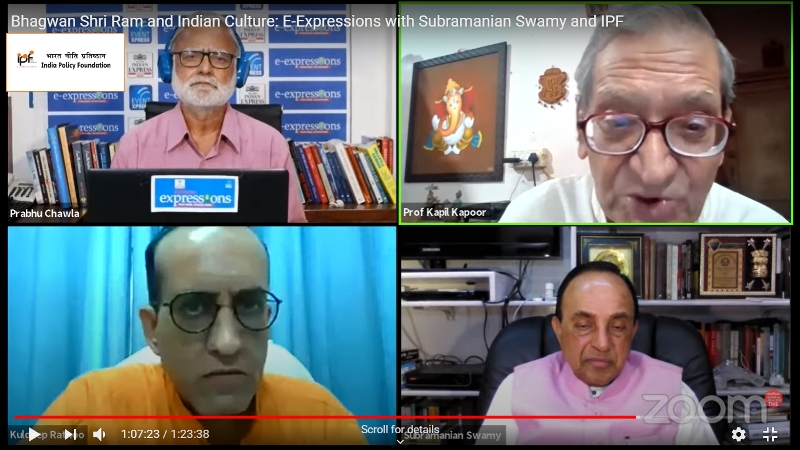
The Ayodhya Ram Mandir Bhumi Pujan has once again brought to focus how Bhagwan Shri Ram has been a unifying force for India.
In a webinar organized by India Policy Foundation in association with the New Indian Express, this pertinent topic was discussed.
The panelists included Dr Subramanian Swamy, Rajya Sabha MP and Prof Kapil Kapoor, Chairperson, Indian Institute of Advanced Study, Shimla. The session was moderated by Shri Prabhu Chawla, Editorial Director, The New Indian Express and Dr Kuldeep Ratnoo, Director, India Policy Foundation.
Shri Chawla opened the discussion with a question on the connection between Ram Rajya and the Indian culture. To this, Dr Swamy answered that Shri Ram was Maryda Purushotam who was morally upright and whose life we could imitate. He emphasized that if there is morality, then society will prosper and this has always been the highest value and Shri Ram symbolized that. He also added that maryda or morality is the basis of sanskriti or culture.
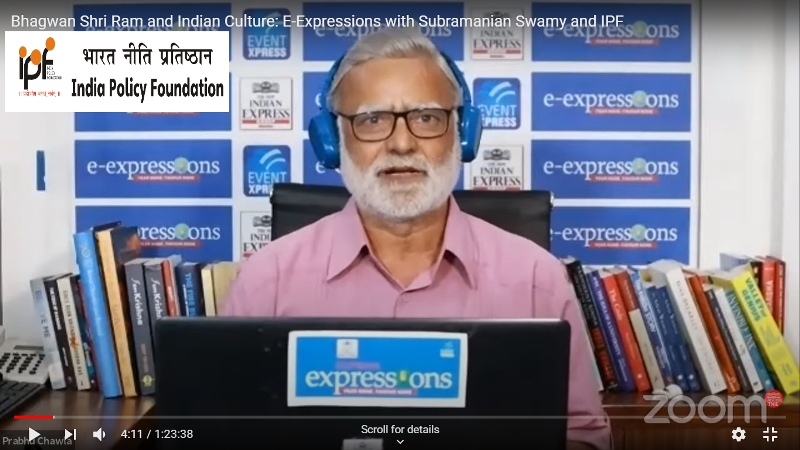
In continuation of this, Shri Chawla asked Dr Swamy whether he saw any leaders who follow the principles of maryada. To this, Dr Swamy replied, “It is kaliyug and you can’t expect the same perfection that the yug of Shri Ram had. Even during Shri Ram’s time, you had all kinds of people. You had Manthara provoking Kaikeyi to revolt when she was actually in a mood to rejoice. But the victory of morality was always there. The more we remember Shri Ram, the quicker will the kaliyug go.”
Focusing on the message that the construction of Ram Mandir will give out, Dr Swamy opined that the message would be that India is a continuing civilization and those who try to distort it will not succeed even if it takes 600 years.
“We will restore our ancient traditions in modern perspective. That is what it implies. We fought for it because Shri Ram was born there. Also, that is our constitutional right. It is part of the basic structure of our constitution which cannot be amended. And the second thing is that we have had 600 years of Islamic onslaught and 150 years of the British Christian exploitation and brain washing. All that has to be overthrown. We need to have our original culture in modern form. Our Shashtra were always written and rewritten. Today our Shashtra is the Constitution. So according to the Indian Constitution, we will rebuild our society,” he added.
Taking on from this point, Prof Kapoor threw light on what is meant by the continuation of Indian civilization. He said, “India’s is a civilization informed by culture – Susanskrit Parampara/Sabhyata. If we have to define, I will say Bharat Bhoomi is Yog Bhoomi, according to Vishnu Purana. India’s civilization is centered in knowledge. India’s culture is Moolya Adhaarit– value centered. Indian society has a unity of consciousness (ekatmakta). The Sanatan gyan parampara (Sanatan Knowledge Traditions) had given birth to this unity of consciousness. There is oneness. We are unconsciously inheritors of the world’s oldest continuous civilization based on knowledge. We have no sacred texts. We have knowledge texts like Vedas. We have preserved them not because this is what God has said, we have preserved them because it is knowledge. As the Bhagavad Gita says, nothing purifies like knowledge. So, society (samaaj) is ekatma (unified as one) because of the jeevan moolya (life values).”
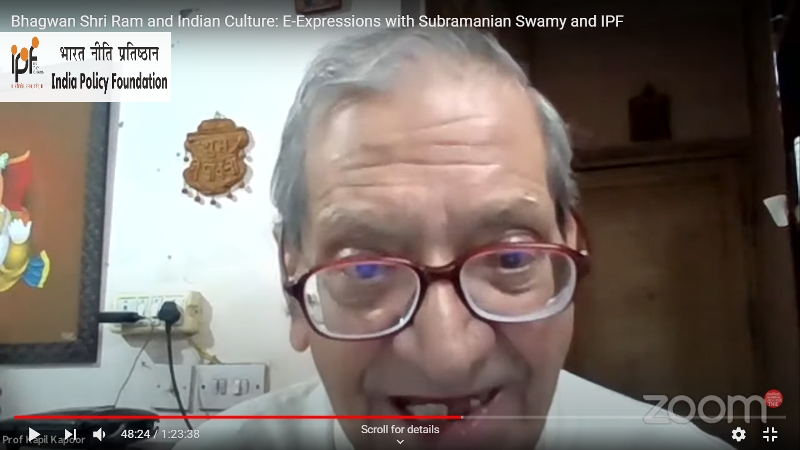
Elaborating further, he said, “The continuity of civilization lies in the continuity of these foundational values which have informed our civilization. For example, in the Mahabharat, we have one parva where Yudhisthir and Draupadi are seen discussing and Yudhisthir tells Draupadi that his ancestors had told him that forgiveness is the biggest virtue. And this is about 3000 years Before Christ.”
He added that Bhagwan Ram’s virtue was also that of forgiveness which was why there was no wavering of emotions when he was asked to go on exile on the day of his enthronement. The next big virtue is compassion (daya). And the biggest of all virtues that was there in Bhagwan Ram was that of sacrifice (tyaag). He lived like an ideal human being and there were no miracles when compared to Bhagwan Krishna. He had to build a bridge to cross the ocean and there were indeed no miracles that took place.
Taking the discussion forward, Shri Chawla asked Dr Swamy to elaborate on the uniqueness of a culture which is continuing from Ram Rajya.
Dr Swamy went back to the points made by Prof Kapoor and said that forgiveness has to be in the context of the occasion and on the full understanding that the person has been thoroughly defeated. He pointed to the example of Prithiviraj Chauhan who gave forgiveness to Muhammad Ghori several times and how India had to pay a heavy price for it.
Prof Kapoor intervened and threw light on the some of the important qualities of Bhagwan Ram which had ensured a continuation of values. He said, Bhagwan Ram had a lot of patience. He recollected how his mother used to advise him that if he is hungry for two rotis, then he should have only one. That is patience (sanyam). Then comes morality (maryada) which means to have only what is required to satiate one’s needs. After that comes law (niyam) which stands for the preferred way of doing something. He said at the core of all this lies, compassion and respect for all including all living beings and nature. The Indian value system was always based on reuse and recycle. This is in stark contrast to today’s generation where it has become all about indulgence in place of patience, freedom in place of law and morality, and the culture of ‘dispose-off’ in place of reverence.
Dr Ratnoo pointed out that there is a problem in the present generation where an issue is viewed from the angle of the current legal system or senstivities. He said it was important to remember that Bhagwan Shri Ram during his vanvas or exile united the entire country. He broke all the socio-economic barriers and even now remains a unifying force for the entire India.
Taking this idea forward, Dr Swamy said there are six incidents from Bhagwan Ram’s life that needs to be remembered – One, when Shri Ram moved through the entire country, he showed his national outlook. In Kishkindha when he defeated Bali and got Sugreev on his side, Laskhman had asked Shri Ram why should they take Vanars to fight when the famous Ayodhya army was at their disposal. So, Shri Ram explained to him, if we call that army, there will be nobody to feed them and look after them. The people whom Lakshman called Vanars are local people who were generous enough to take them in as their guests. Shri Ram said they need to be respected and they will fight with much greater zeal.
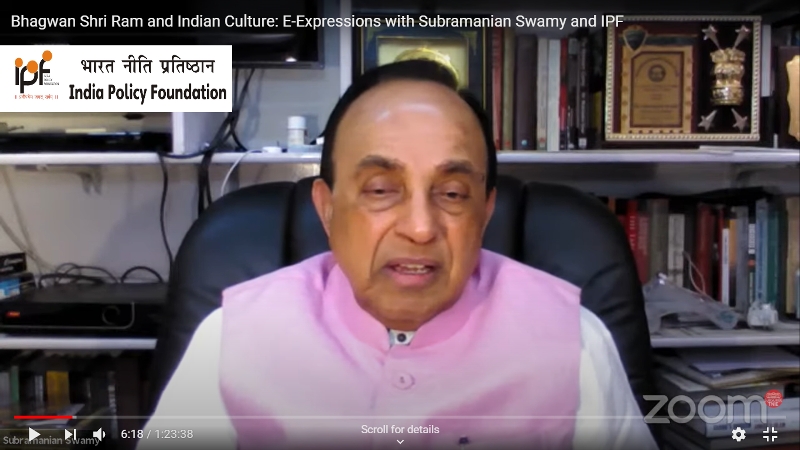
Two, when it came to Sabari, Shri Ram didn’t hesitate eating the leftovers. Three, when Shri Ram went to Lanka and when Vibhishna defected and came to his side, Shri Ram held his coronation. Lakshman questioned this and Shri Ram told him that he was there only to take Sita back and is not after power. Four, after winning the war when Lakshman asked if they should go back as they have everything, Shri Ram said there cannot be anything greater than Janmabhoomi or the motherland. Five, Shri Ram hid behind a tree and killed Bali. Bali in his last moments called him and said this was the height of immorality. To this Shri Ram said, “who are you to preach morality when you yourself have stolen the wife of Sugreev, snatched his kingdom. Morality can be spoken only between two moral people.” Six, in the case of Sita, Shri Ram promised right after marriage that he will never look at another woman. And Sita in turn gave a promise that if during his reign any problem arises because of her, she will go away. So, it was not Shri Ram who sent her away. It was she who insisted to leave for Vanvas (exile into forest).
Dr Swamy pointed out that all these facts are ignored and there is a campaign going on in the western world which is derogatory to the idea of what Ram represents.
Shri Chawla then went on to ask the panelists why is Shri Ram being classified as a Hindu symbol?
Dr Swamy stressed that Hindus are not imposing Shri Ram on anyone.
Prof Kapoor said, “Hindus do not limit Bhagwan Shri Ram to a particular sect or themselves. It is the other people. Those who are envious of the continuous unbroken tradition of Hindu civilization, they do psychoanalytical interpretation of Indian epics like Shri Krishna was a war monger and so on. In India we always had Sanatan Dharma which was an ideal way of life.”
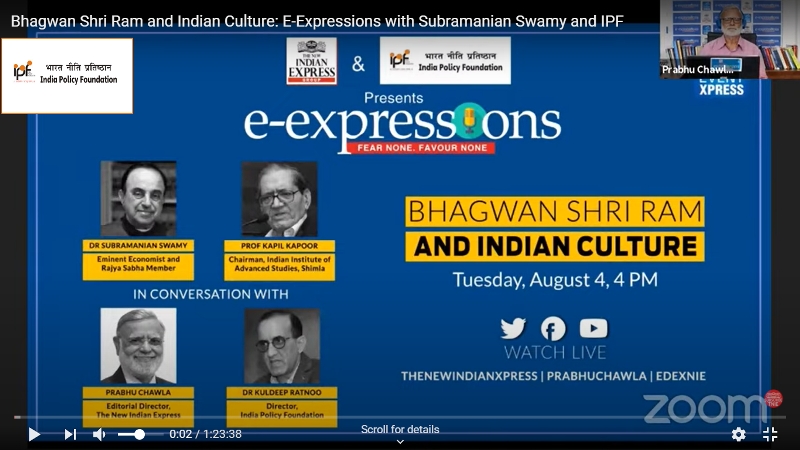
He added that the term Sindhu came to be known as Hindu in the beginning because it was difficult for those from the other countries to pronounce it. It came to be associated with religion only in the 13th century by Sant Gyaneshwar when India was being attacked by another religion.
Dr Swamy pitched in and said, “All the division that are being created in the name of Hinduism doesn’t belong to Hinduism. Varna system is based on Gunas (virtues). We have always said the whole world is ours – Vasudhaiva Kutumbakam.”
Dr Ratnoo brought the attention of the panelists to the various rights movements that are going on and said, Shri Ram had treated everyone including the animals at par and had already given a direction on how to live.
Dr Swamy agreed to this point and said, this is the inclusiveness we talk about and now unfortunately, this is used against Hindutva.
Dr Ratnoo also posed a question on the impact of Bhagwan Shri Ram on Indian literature.
To this, Prof Kapoor answered that Valmiki Ramayan and Ram Katha has spread not only in India but it has spread across Asia. Kamban was the first person who put Valmiki’s Sanskrit Ramayan into Tamil in the 9th century AD. Ram Katha has been instrumental in vernaculising Indian languages and Ram Katha is the substance of much of Indian art and folk performances and folk literature. He emphasized that from birth to death, Shri Ram is an integral part of the life of Indians. Shri Ram is a symbol of India’s culture and it is because of that Shri Ram is worshipped as an Avatar.
Shri Chawla posed an interesting question to Dr Swamy on the economics of Ram Rajya.
Dr Swamy replied, “There is a term coined by Deen Dayal Upadhaya called Ekatma Manav vad (integral humanism). The highest status in society is of those who are in charge of knowledge. Next come people who are defending the nation. Then come those who create wealth. There you are recognized only if you create an excess of wealth and that is donated to society. So, philanthropy was a huge factor. If you look at the western economies, it is all one dimensional. That is the difference between the Ram Rajya economics and the economics of the West. The whole economy is structured around to make the people morally and spiritually superior.”
Wanting to know further, Shri Chawla asked, “What is Ram Rajya and how will it be different?”
Dr Swamy said, “In a nutshell, it means the implementation of the Indian Constitution. Because all the concepts propagated by Ram Rajya are there in the Directive Principles of State Policy, in the Fundamental Rights, in the advocacy of rights etc.”
Shri Chawla intervened and asked whether those who wrote the Constitution were better Ram Bhakts?
Dr Swamy said in his reply, “Absolutely, Ambedkar was the finest. Nehru made him bitter so he became very harsh towards the end of his life. If you see his thesis in Columbia University in 1915 and subsequently his book, he is perhaps the most articulate proponent of Hindutva that I can think of. The fact of the matter is among those who framed the Constitution there were three main individuals. One, the President of the Constituent Assembly, Dr Rajendra Prasad; two, the President of the Fundamental Rights Committee, Dr Sardar Patel and three the person in charge of the Drafting Committee, Dr B.R. Ambedkar.”
On a question on why Americans should follow Ram Rajya, Dr Swamy said he would ask them to give up their pursuit of pleasure, have many dimensions and start making a synthesis of it. He stressed on the “harmonization of resource allocation instead of maximization of profits.”
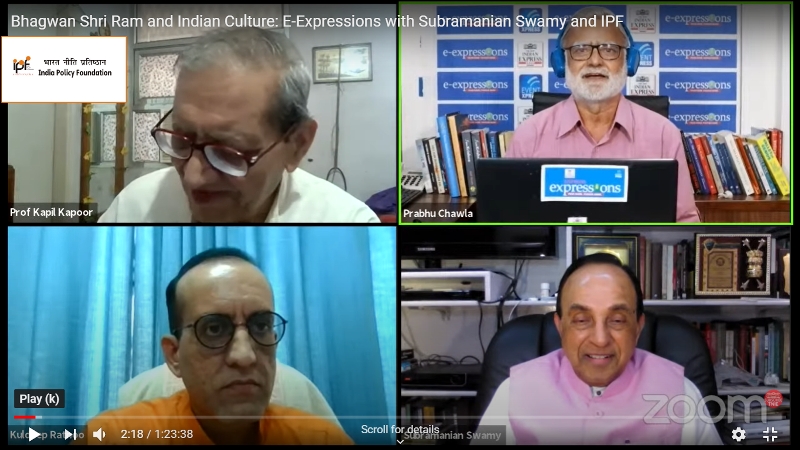
Shri Chawla asked if the building of Ram temple would lead to more tension?
Prof Kapoor answered in the negative and said, in villages, people don’t bother much about the religion and caste. He reminded everyone that even Muslims used to take part in Ram Leela before and it is that kindness and patience that we have all forgotten. Speaking on the economics of Ram Rajya, he said wealth has to be used in a just manner. The essence of Ram Rajya is that happiness has to be sought for everyone not just for oneself.
Dr Ratnoo posed a question on whether there will be emergence of sattvic forces once again and the defeat of demonic forces since the Shri Ram temple is being constructed.
Dr Swamy said, “We still need people who will fight for the country and spill blood. So, the literal meaning of sattvic forces will not fit into that. I think what we need is the combination of the sattvic, rajasic and tamasic forces. That is why we have the concept of varna. We have to defend ourselves recognizing the evil forces against us.”
Prof Kapoor added that whenever we have been attacked, we have had a Mahapurush protecting us with weapons and knowledge. Destruction and rebuilding have been going on in India for long and Hindus have never accepted defeat.
Pointing to Karl Marx’s Notes on Indian History where he had mentioned that the great valiant Persians were defeated and converted in 30 years but it took the invaders 400 years to cover eight miles to attack the Hindus, Prof Kapoor said this happened because Iran’s ruling class was morally corrupt. But the Brahmins of India were moral leaders and they organized the resistance. He said that was the reason why the invaders broke the temples and destroyed the Brahmin settlements. The British people also followed anti-Brahmanism due to the same reason.
“The temples are symbols of our freedom,” he added.
Shri Chawla posed a question to Dr Swamy on whether there will be less tension in politics now. To this, the latter said that the anti-Ram section had been in power for so many years. They lost power because Hindu consolidation happened. He also pointed out that many in Congress don’t realise that the process began with Rajiv Gandhi when he showed the Ramayan serial on television despite the objections of his party people. And then came Narasimha Rao who gave an affidavit in the Supreme Court that the entire land will be handed over to the Hindus if there is any evidence found of a Hindu temple being there.
Dr Ratnoo posed an important question on how can social media be effectively utilized to instill the Indian value system.
Dr Swamy said, there are five things that he propagates. Elaborating further, he said, we need to learn what our true identity is and based on DNA studies, we are all one people. Every Indian language has a huge proportion of Sanskrit words. He pointed out that it is there in Article 3 of the Indian Constitution which says that Hindi will have to be more Sanskritised with time. He opined that it is important to develop Hindi to that point. He brought attention to the fact that Sanskrit is now thought of as the language of Artificial Intelligence and it is the language of the future. Third point he made was to teach correct history and fourth to teach integral humanism as the economic principle on which to build our theology. Fifth is Ram Rajya and the concept of governance arising from Ram Rajya. He said, if we can propagate these five things, we will have a new Indian born in a very short time.
Dr Ratnoo asked whether a future can be foreseen when Indian Muslims accept Bhagwan Shri Ram as their role model just like Indonesian Muslims.
Dr Swamy replied, “The Christians have already accepted it and the Muslims should also accept that their ancestors are Hindus. If that happens then like olden times, Muslims will start integrating Indian culture into their lives while still adopting all their religious practices. Hindu Muslim unity is inevitable in the future.”
Watch the whole discussion here:
https://www.youtube.com/watch?v=Q2kw-rtkQ2s
(Report prepared by Lekshmi Parameswaran. Inputs by Vikrant Tyagi)